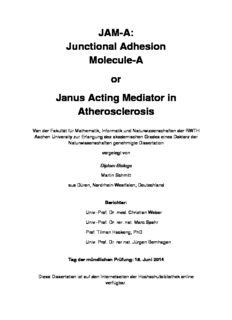
JAM-A: Junctional Adhesion Molecule-A or Janus Acting Mediator in Atherosclerosis PDF
Preview JAM-A: Junctional Adhesion Molecule-A or Janus Acting Mediator in Atherosclerosis
JAM-A: Junctional Adhesion Molecule-A or Janus Acting Mediator in Atherosclerosis Von der Fakultät für Mathematik, Informatik und Naturwissenschaften der RWTH Aachen University zur Erlangung des akademischen Grades eines Doktors der Naturwissenschaften genehmigte Dissertation vorgelegt von Diplom-Biologe Martin Schmitt aus Düren, Nordrhein-Westfalen, Deutschland Berichter: Univ.-Prof. Dr. med. Christian Weber Univ.-Prof. Dr. rer. nat. Marc Spehr Prof. Tilman Hackeng, PhD Univ. Prof. Dr. rer nat. Jürgen Bernhagen Tag der mündlichen Prüfung: 18. Juni 2014 Diese Dissertation ist auf den Internetseiten der Hochschulbibliothek online verfügbar. Printed by: Proefschriftmaken.nl || Uitgeverij BOXPress Published by: Uitgeverij BOXPress, s’Hertogenbosch ISBN: 978-90-8891-903-9 © 2014 Martin Schmitt, Munich This PhD-thesis was completed within the Euregio Cardiovascular (EuCAR) International Research Training Group (IRTG) 1508 ‘Arterial remodeling’ at RWTH Aachen University Spokesperson: Univ.-Prof. dr. rer. nat. Jürgen Bernhagen Institute of Biochemistry and Molecular Cell Biology and Maastricht University Spokesperson: Prof. dr. Tilman Hackeng, PhD School for Cardiovascular Diseases (CARIM) Contents Chapter 1 General Introduction 7 Methods and Results Chapter 2 Endothelial JAM-A guides monocytes into flow-dependent 38 predilection sites of atherosclerosis Chapter 3 Atherogenic mononuclear cell recruitment is facilitated by 74 oxidized lipoprotein-induced endothelial junctional adhesion molecule-A redistribution Chapter 4 TNF- and IFN- promote lymphocyte adhesion to 98 endothelial junctional regions facilitating transendothelial migration Chapter 5 Hyperreactivity of junctional adhesion molecule A-deficient 126 platelets accelerates atherosclerosis in mice Chapter 6 General Discussion 153 Summary 168 Zusammenfassung 173 Samenvatting 177 Curriculum Vitae 182 List of Abbreviations 188 Acknowledgement 194 1 Contribution to the General Introduction (chapter 1): 1 This part was solely written by Martin Schmitt. 1 Chapter 1 1 General Introduction CHAPTER 1 1 Atherosclerosis Atherosclerosis is a chronic inflammation of the arterial wall and causes inter alia rearrangement of cellular and subcellular components. Besides some other diseases like thromboembolic disease, rhythm disorders and hypertension, atherosclerosis is the main contributor to cardiovascular diseases. Atherosclerotic lesions are mediated by modified low density lipoproteins (LDL) triggered immune cell influx, accumulation of dead mononuclear and vascular cells, reorganization of smooth muscle cells (SMC) as well as deposition of extracellular matrix like collagen. Most atherosclerotic lesions cause luminal narrowing comprising altered shear stress conditions, until unstable lesion rupture releases prothrombotic material into the lumen, initiating coagulation and causing occlusion. Dependent on the site of occlusion this may lead to myocardial infarction or stroke, two of the most important sources for illness and death in developed countries1-3. The onset of atherosclerosis is represented by the formation of a “fatty streak”, an accumulation of highly lipid-laden macrophages4. In a classification of plaque stages by Virmani and colleagues those intimal xanthomas still count for the non-atherosclerotic intimal lesions without necrotic core or fibrous depositions covering the lipid core, often referred to as fibrous cap5. Intimal macrophages phagocytose excess lipids, transform into “foam cells” and contribute together with activated endothelial cells and further intimal immune cells to the inflammatory milieu by secreting a great variety of cytokines, like Interleukin (IL)-1 and -6, and tumor necrosis factor (TNF)-α6, chemokines and proteases. Progressive atherosclerotic lesions finally evolve from this enhanced secretion of atherogenic factors. Those lesion stages were categorized by Virmani et al. as pathological intimal thickening comprising SMCs in a proteoglycan-rich matrix and extracellular lipid accumulations and as fibrous cap atheroma containing a well-formed necrotic core and a covering fibrous cap. Finally, matrix-metallo protease mediated weakening of the fibrous cap results in a higher susceptibility to plaque rupture followed by vessel occlusion. The role of disturbed flow in atherogenesis Besides the generally accepted notion that hyperlipidemia induced excess of modified LDL in the vessel wall is responsible for activation of the endothelial cell layer and thus increasing mononuclear cell recruitment1, 3, also alterations in laminar shear stress, preferentially occurring at branching points or curvatures activate the endothelium and cause enhanced mononuclear cell extravasation into the vessel wall7, 8. First evidence for shear stress dependent mononuclear cell extravasation was found in the mid-eighties by differently localizing 10
Description: